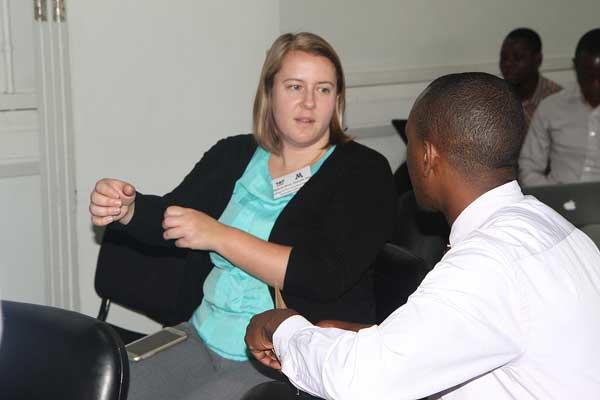From Population to Person
July 15, 2018

One Faculty Member's Quest to Use Big Data to Stop AML
MINNEAPOLIS — With a five-year survival rate of 27 percent, acute myeloid leukemia (AML), which starts in bone marrow and quickly moves into blood, is one of the most challenging cancers to treat in adults.
There are several subtypes of AML and each responds differently to different therapies. That’s why a precision medicine approach, which customizes different treatments based on the uniqueness of one’s DNA, is more important than ever.
Recently, the FDA approved the first-ever drug to target a genetic mutation linked to AML. But now the hard work of showing the drug’s effectiveness in a large and broad population of patients has begun. With expertise in pharmaceutical and outcomes research, few people are better positioned to lead this charge than Associate Professor David Stenehjem, Pharm.D.
A specific drug for a specific gene
The novel drug that Stenehjem is studying, called midostaurin, targets an especially problematic subtype of AML called FLT3-mutated AML. One out of every three AML patients carry the FLT3 mutation, and those who have it relapse faster and die sooner than patients with other forms of AML.
Until recently, no drug has existed that targets mutations linked to AML, let alone FLT3.
Stenehjem believes that FLT3 inhibitors, like midostaurin, could make all the difference.
“FLT3 is a tyrosine kinase, which gives leukemia cells a signal to continue to grow, divide, and proliferate in an unrestrained manner,” explains Stenehjem. “Midostaurin works by inhibiting this tyrosine kinase and, ultimately, helps shut down the unrestrained proliferation of AML cells.”
Beyond clinical trials: drugs in the real world
But to be sure that midostaurin truly works, researchers must now show that it helps large populations of patients, and not just those selected for clinical trials.
“We know from the confines of clinical trials that midostaurin works well in a highly select group of patients who follow a pre-specified protocol,” Stenehjem says. “We are now working to determine the effectiveness of this drug in real-world populations.”
To achieve this goal, Stenehjem and his team have partnered with a major drug company to look at outcomes for large groups of patients with FLT3 mutations who take midostaurin versus those who do not.
So far, they have completed a baseline study of approximately 200 AML patients who have received standard AML therapies. The study captures precisely how these patients were treated and clinical outcomes such as how long they lived and how quickly their AML returned. It also includes economic measures such as health care utilization and costs.
The next big step for Stenehjem’s team will be to compare these patients to those who have taken midostaurin for FLT3-mutated AML, crucial work that they plan to begin after midostaurin has been on the market for approximately one year.
The power of big data
Stenehjem has worked on the scientific and clinical sides of pharmacy. He started his career conducting research in the lab of a pharmaceutical company and later launched a pharmacy practice of his own.
But as time went on, Stenehjem began to question the effectiveness of the drugs he prescribed and whether their benefits outweighed their costs and side effects.
“I was intrigued that many of our drugs were getting approved with very small margins of benefit,” he says. “This is especially true in oncology where we’ve seen approvals for drugs that provide as little as two weeks to two months of improvement in survival before the cancer returns. I wanted to examine whether these therapies are worth it.”
So Stenehjem’s path shifted into the rapidly growing field of outcomes research, which today is guiding his research on midostaurin in FLT3-mutated AML.
Outcomes research uses extensive patient data, typically from electronic medical records, that is pooled from different hospitals or institutions to determine the most effective and customized ways to detect, prevent, and treat different diseases.
“So much of this research is about quality data being collected by multiple institutions on a large scale,” explains Stenehjem. “Once we know the data points that are important to measure, it becomes essential to collect the data in a systematic and reproducible manner.”
Now, after plotting the key data points for studying AML therapies, Stenehjem’s team is working to roll them out to academic cancer centers nationwide that will uniformly capture outcomes for FLT3-mutated AML patients. This will increase the number of patients they are able to study from hundreds to thousands, lending validity and credibility to the study.
Drawn to Duluth
When he joined the College of Pharmacy, Duluth, Stenehjem was drawn by the allure of joining the #2 ranked pharmacy college in the nation.
But another attraction was the chance to deliver innovative cancer trials to a community he cares deeply about.
Stenehjem, a Minnesota native, fell in love with Duluth as a doctoral student in the College of Pharmacy.
Today, he is thrilled to be back as a faculty member.
“By living in Duluth, I’m able to work at a premier college of pharmacy, while living in a smaller community surrounded by wilderness,” he reflects. “I feel very blessed to have this opportunity.”
Excerpted from a University of Minnesota Foundation story written by Lesley Schack


